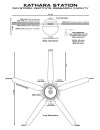Just got to the part where Important Documents are signed and had to pause listening.
So some Starfleet people, it seems, could've at least partially eased one of our heroes' conscience. And they didn't, letting the person live with the guilt for years. Man, that's cold. Sometimes these Starfleet people behave as if they aren't really your friends! ;-)
So some Starfleet people, it seems, could've at least partially eased one of our heroes' conscience. And they didn't, letting the person live with the guilt for years. Man, that's cold. Sometimes these Starfleet people behave as if they aren't really your friends! ;-)

